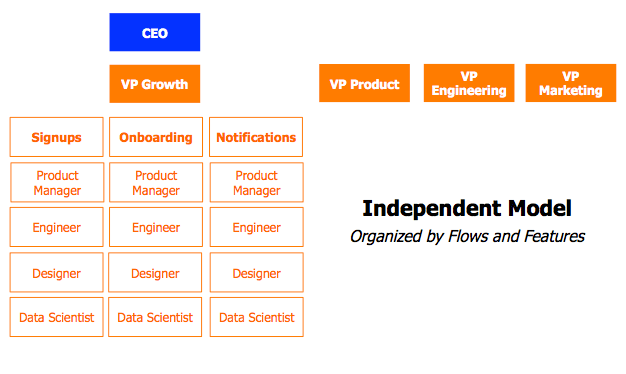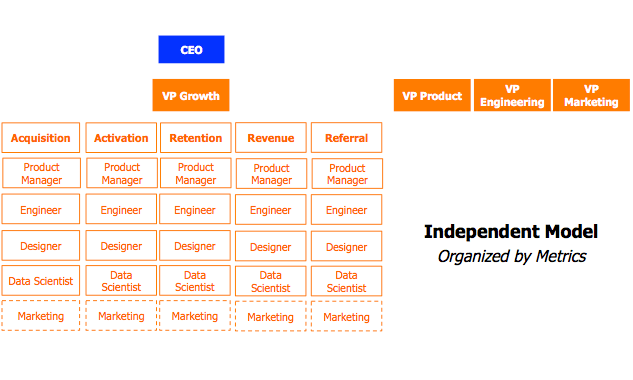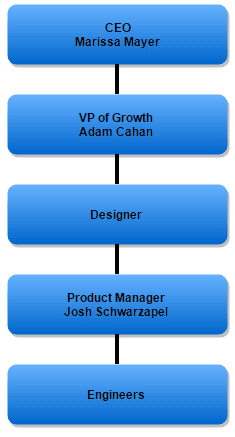How to Structure your Growth Team
This post will provide a clearer understanding of why planning for growth is important and how to structure the team that'll get the job done.
Growth is so fundamental to startups that Y Combinator founder Paul Graham makes them virtually equivalent in his legendary essay, “Startup = Growth.”
That’s why it’s such a mistake for startups to delay putting together a growth team responsible for that growth.
As Wealthfront VP of Growth Andy Johns points out, “startups will build a really robust finance organization, but not a team with the responsibility to measure, understand and improve the flow of users in and out of the product and business.”
But finance is, if not easy, then at least (generally) based on best practices that have been developed over centuries. Growth—or at least our concept of it—is pretty new.
Figuring out how to structure your startup’s growth team starts with understanding its goal.
Building a user-aligned team
A growth team is designed for one thing: the movement of users into and out of your product.
It’s one thing to attract bevies of new users, but the growth team has to manage the experience by continuously aligning strategies with customers’ needs. Keep customers satisfied by creating a company that is invested in keeping customer needs the priority.
Alyssa Henry, Engineering Lead at Square, agrees. She oversees the design, product and engineering teams as they develop products that help their merchants do business better. Her approach was to reorganize her teams into three divisions: payments, financial services and marketing services.
Why those three? Because payments, financial services, and marketing services represented the three most crucial parts of the Square customer experience—as such, they were the three most important things to get right if Square wanted to grow.
What you want to make sure is you’ve got teams that have clear customer focus: Who are we building for and why. Making sure that was really really clear. And then as teams grow, you want to make sure you get that decision making and ownership pushed down as far as you can go.
– Alyssa Henry, Engineering Lead at Square
While this approach worked for Square, companies have to choose an approach that fits with their specific growth goals and maximizes customer experience. Startups are initially only made up of a handful of people. Flexibility is more important at this stage than it is for an enterprise. Your business type will determine the best way to approach structuring your growth team.
What kind of growth team structure do you need?
The structure you decide to build your company on will depend on where you are in your life cycle and your size. Startups and enterprises have different goals so it only makes sense that their growth teams are structured in a way that helps with these goals and doesn’t disrupt productivity. Let’s take a closer look at how to structure growth teams for startups versus enterprises.
Structure for startups
Micro team
If you’re just starting out, chances are you’re small. Your entire business might consist of less than 10 people. At this stage you can probably get away with one or two people working closely with the CEO. This team decides what areas to focus on and gets to work doing it.
Because the team’s so small, everyone has visibility into progress and can move quickly on new ideas. No need for multiple meetings or buy-in from other teams.
One pitfall with this approach is the limited amount of experimentation you can do. Your customer base is still growing so the strategies you use have to be very focused.
Dedicated team
As your company gets bigger, another approach is to put a larger team in place. You can decide how many people should be on this team based on your size but 5-10 is a good start. The team can still roll up to the CEO, but with a larger group, a dedicated point person is needed.
Responsibility for growth is more spread out and more people are accountable. Ideal members of this team would be product managers and designers. As the team grows, you can add engineers, data scientists and analysts.
To make this approach successful, clearly define each person’s role and figure out accountability early on. Each person on the team is specialized and may have their own goals to consider in addition to overall growth. Make sure there’s alignment in goals. Consider regular standups as a way to monitor progress.
Structure for Enterprises
Medium published research that outlined effective team models. 20 growth leaders were interviewed and the study identified two types of growth team structures: independent and functional.
Independent
Who uses this model: Uber and Facebook With this model the VP of growth leads and reports up to the CEO.
This model can flow in one of two ways:
1. Flows and features
- The VP of growth manages teams that oversee specific processes. They see all the moving pieces and provide progress reports to the CEO and make adjustments within each team to ensure specific goals are met.
- Each team has a product manager, engineer, designer and data scientist assigned to it.
- Each team is focused on its own specific task. In this example we see that the signups team only works on growth plans that involve the sign-up process: changing the flow, the copy on the page, etc. They also monitor conversion rates for all signup flows.
[Source](http://[Source (https://medium.com/swlh/how-do-you-choose-the-best-growth-team-model-632ad5a85be9#.obiax5czu)

2. Metrics
- The VP of growth manages teams that work on key performance metrics such as acquisition and activation.
- Each team consists of a product manager, engineer, designer, data scientist and in some cases, a marketer.
- With this approach, specific metrics like acquisition and conversion rates that are important to your growth are identified, and each team is focused on that one specific metric.
Since the VP of growth oversees all of the teams, they can ensure that they’re all working together. Your chosen metrics may flow into one another and affect each other. In the example below, acquisition affects activation. If you’re bringing on lots of new customers but only a fraction of them “activate” or use your product, there’s a problem. The VP of growth can identify this and run some analysis with the acquisition and activation teams to determine what’s wrong.

The independent model works since teams can adapt quickly. Each team is independent and flexible but the VP of growth pulls everything together. Uber built feedback loops using this model that allow them to track growth based on referrals. One loop is the number of new riders resulting from referrals. If there’s a drop in this kind of referral, they can adjust and offer current riders a discount or special offer for referring new customers.
One main pain point with this model is the silo approach where each team pushes for their own specific growth. This affects overall user experience. If there’s a push for signups but the onboarding team isn’t prepared for the surge of new users, user experience suffers and customers leave. This is where the VP of growth is needed to step in and make sure growth team initiatives work well together.
Functional
Who uses this: Pinterest, Twitter, LinkedIn, BitTorrent and Dropbox
In this model:
- The VP of product reports to the CEO and is the point person for growth.
- Product managers, engineers, designers and data scientists act as “functional heads” and report up to the VP of product.
- Each functional head makes their own decisions on which growth opportunities to pursue.
This structure works best for companies prepared to put a heavy emphasis on using data to drive their growth. The product manager of signups runs analysis to determine which specific growth tactics are the best ones to focus on. Then they measure the outcome. The engineer of signups has to do the same thing. They figure out which specific engineering tasks to focus on.

This approach works well because each team groups together people who have similar experience and will manage their own growth goals. The VP of product works with each functional head such as product managers and engineers. At BitTorrent, the head of product decides which growth and non-growth metrics to focus on and other teams have faith that he’s chosen the best plan because that’s his expertise. They expect that he’s measuring outcomes and adjusting as needed.
The issue with this model is that it relies on analysis of long-term customer behaviors in order to determine if growth has been successful. This information is used to determine whether user engagement is where it needs to be.
Yahoo! case study
Let’s take a closer look at Yahoo!, who uses an independent growth model. In 2012 Yahoo! identified that there was potential to grow their mobile division. They were putting a lot of energy into it but to their credit, they understood that in order to grow, they needed to take it more seriously. It was time to invest in growth, so in came the Growth and Emerging Products team.
The first person hired to the team was a designer followed by a product manager and eight engineers, all led by Adam Cahan. His belief is that you need to “bring together exceptional people, people from different disciplines in product, engineering and design to create experiences that are exceptional to their users’ daily lives.”
Their structure for the mobile division looked something like this:

Their goal was to grow the division by onboarding new customers and aiming to “improve user experience and align the team around that.” They built products that met the needs of their customers.
The team was made up of less than 1% of the total company but has grown to 4%. In just two short years they increased revenues in this division to $1.2 billion.
Next step: make your team stable
Team stability is necessary for long-term success, especially in startups where growth is a key part of doing business.
Build a team that works well together to maximize productivity and performance. Chris Fry, Engineering SVP at Twitter says that in order to get to this point, “keeping teams together for at least six months, and ideally a year or more” is best.
This is an important step in making sure that the effort put into growth is sustained. If there’s little trust in a team or they’re dealing with constant change, progress will slow to a less than optimal pace. Pick your growth team wisely.
Key takeaways about structure and growth
You should now have a clearer understanding of why planning for growth is important and how to structure the team that’ll get the job done. Embedding the importance of growth within your company culture is an important first step. It will take time to adjust but you’ll be on the right path to long-term success. When you’re ready to put your growth team in place, consider this:
- Don’t be intimidated. Knowing that you have to grow is one thing but actually setting out a plan and building a team around it can seem like a daunting task. Take it one step at a time by figuring out if now’s the time to start your growth strategy and who you want in place to lead the charge.
- Decide what your long-term goals are for your growth team. Use a structure that works best for your company’s vision and values. You aren’t locked in so if something’s not working, change it.
- Choose a growth champion who knows what has to get done and how to do it. You’re going to need someone who’s driven, will command respect and who will get down to work. Take the time you need to find the right person.
- Don’t let up, keep growth at the core of your business. The growth team is accountable but everyone needs to take a hard look at what they can do to help the overall picture. Does the marketing team need to offer new programs for referrals? Or do designers need platforms that are super simple to use? Make sure you involve every team when it comes to growth.
Cover image from #WOCinTech Chat

Alicia Shiu
Former Growth Product Manager, Amplitude
Alicia is a former Growth Product Manager at Amplitude, where she worked on projects and experiments spanning top of funnel, website optimization, and the new user experience. Prior to Amplitude, she worked on biomedical & neuroscience research (running very different experiments) at Stanford.
More from Alicia




